Other locations
Links to sites with information on some of these locations can be found on the Links page.
There is a specific page (Visiting the "Wuthering Heights" Locations) giving details on how to some of visit the sites below.
A Map of Wuthering Heights and Emily Brontë Locations
Click on the Markers for information or click here to see a larger map
Haworth Parsonage
No building is more associated with Emily Brontë than the parsonage at Haworth where she lived most of her life. It is the site of the Brontë Parsonage Museum and has probably more reference material on Emily and her works than anywhere else. She moved to the parsonage when she was less than two years old and, apart from relatively short periods at school or teaching, rarely left it. She died (reputedly) on the sofa in the dining room and is interred in the church opposite the parsonage (see below).

The Parsonage

The Parsonage and the graveyard
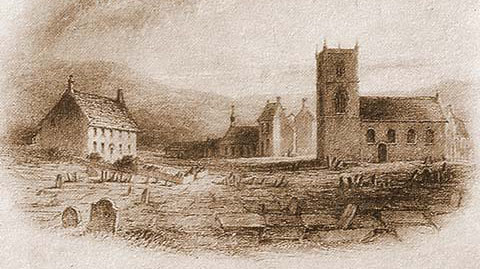
Mrs Gaskell's drawing of the Parsonage and Church
showing their isolation at the time of the Brontës
At the time of Emily's life, the Parsonage and its location looked very different. The trees that crowd the graveyard had not been planted and the house was right on the edge of the town, bordering directly onto the moors. The Parsonage was also smaller as the northern extension was not added until after she and her family had died.
As fascinating as the building is though, there is nothing there specifically connected with Wuthering Heights apart from the reference material in the Brontë Museum library. The map reference of the Brontë parsonage is OS reference SE 0292 3721 (altitude 250 meters). A location map of the parsonage can be seen here.
St Michael and All Angels Church
The church where Emily Brontë's father preached and where she is interred along with her parents, brother and sisters (apart from Anne). It is important to realise that most of the church was rebuilt after the Brontës died so they would not have known the building we see now. The tower is the only original part and has bullet holes which resulted from Mr Brontë's habit of firing a pistol off at it every morning. The family is buried in a vault below (not accessible) but there is a memorial chapel (built in 1964) and plaques (see photo on the Emily Brontë page).

Above left: the church as seen from the Parsonage
Above top right: the church as the sisters would have known it
Above right: the bullet holes in the tower

Interior of the old church with the three-decker pulpit from which Patrick Brontë preached
Ponden Kirk (Penistone Crags)
In chapter 12, Catherine, in delirium, reminisces on Penistone Crags: "This bed is the fairy cave under Penistone crags". In chapter 18, Cathy ponders on the crags from Thrushcross Grange, as Ellen explains: "The abrupt descent of Penistone Crags particularly attracted her notice; especially when the setting sun shone on it and the topmost heights, and the whole extent of landscape besides lay in shadow. I explained that they were bare masses of stone, with hardly enough earth in their clefts to nourish a stunted tree."
Hareton takes Cathy to Penistone Crags on their first meeting and explains about the Fairy Cave to her.

Ponden Kirk
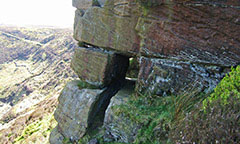
Close-up of the hole in the Kirk
The likely inspiration for Penistone Crags is Ponden Kirk, an outcrag of gritstone rock about one kilometer north of Top Withens and nearly five kilometers west of Haworth. It has a hole in the base which corresponds to the Fairy Cave in the book. Several local legends are associated with it, for example, that a woman passing through the hole will marry within a year. The map reference of the kirk is OS reference SD 9797 3650 (altitude 380 meters). A location map of the rocks can be seen here. There is a page about the rocks at the Megalithic Portal.
Brontë Waterfall
Again a location associated with the Brontës rather than Wuthering Heights, this is a small waterfall on the route from Haworth to Top Withens and is visited by many people exploring Brontë tours. It was very popular with the sisters. The map reference of the Brontë waterfall is OS reference SD 9984 3584 (altitude 280 meters).
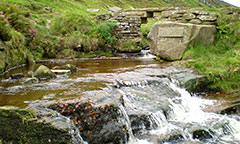
The Brontë Bridge beneath the waterfall
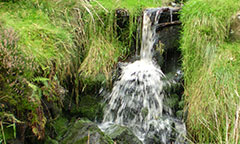
Close-up of part of the waterfall
We set off, not intending to go far; but though wild and cloudy it was fine in the morning; when we got about half-a-mile on the moors, Arthur suggested the idea of the waterfall; after the melted snow, he said it would be fine. I had often wished to see it in its winter power, so we walked on. It was fine indeed; a perfect torrent racing over the rocks, white and beautiful!
Charlotte Brontë, 29 November, 1854
The rugged bank and rippling brook were treasures of delight. Emily, Anne and Branwell used to ford the streams, and sometimes placed stepping stones for the other two; there was always a lingering delight in these spots ― every moss, every flower, every tint and form, were noted and enjoyed. Emily especially had a gleesome delight in these nooks of beauty ― her reserve for the time vanished. One long ramble made in these early days were far away over the moors to a spot familiar to Emily and Anne, which they called 'the Meeting of the Waters'. It was a small oasis of emerald green turf, broken here and there by small clear springs; a few large stones served as resting places; seated here we were hidden from the world, nothing appearing in view but miles of and miles of heather, a glorious blue sky, and brightening sun. A fresh breeze wafted on us its exhilarating influence; we laughed and made mirth of each other, and settled we would call ourselves the Quartette. Emily, half reclining on a slab of stone, played like a young child with the tadpoles in the water, making them swim about, and then fell to moralising on the strong and the weak, the brave and the cowardly, as she chased them with her hand.
Ellen Nussey, correspondence to Mrs Gaskell
Law Hill School
Emily Brontë rarely left her home at Haworth but she did spend about six months at Law Hill School near Halifax as a teacher. The building still remains although it is now a private house. The map reference of the Law Hill building is OS reference SE 1082 2573 (altitude 240 meters) and the location can be seen on the Locations near Halifax page. A picture of Law Hill as it was in Emily's day can be seen on the Inspirations page.

Law Hill today
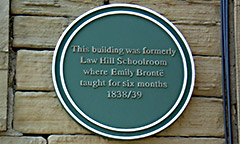
The plaque at Law Hill
Thornton
This is Emily Brontë's birthplace although she was less than two years old when she left it and moved to Haworth. The building, at the moment, is a private house and can only be seen from the exterior. The angular extension to the right of the front door, originally a butcher's shop, was added in 1898 over one of the flower beds. The drawing below shows how it would have looked during the Brontës' time. The map reference of the Thornton birthplace is OS reference SE 1005 3276 (altitude 258 meters). A location map of the house can be seen here.
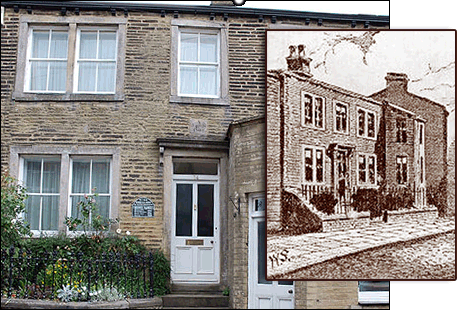
The birthplace of Charlotte, Emily and Anne in Thornton, now and then.